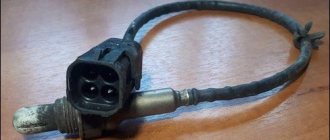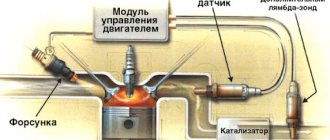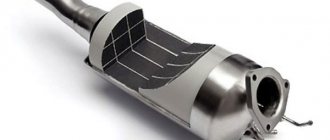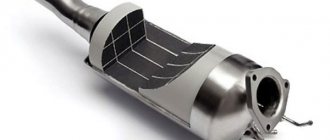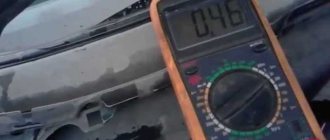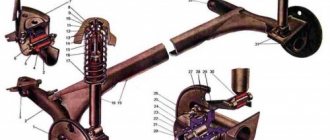Oxygen sensor VAZ 2107 injector
A large number of cars heavily pollute the environment, so the requirements for new cars regarding the content of harmful impurities in exhaust gases are becoming more stringent. They are achieved in different ways, but the most effective is the installation of a catalyst in the exhaust system, as well as adjustment to the optimal composition of the combustible mixture in the engine cylinders. The car’s on-board computer receives a signal from the VAZ 2107 lambda probe, and then, at its command, the composition of the combustible mixture changes.
Replacing the lambda probe
If necessary, remove the engine protection.
The VAZ 2107 lambda probe is located in the exhaust manifold - the most running part of the car. This must be taken into account in your work. Before starting work, you must allow the parts to cool down to avoid burns. The next steps look like this:
- cut the clamps;
- remove the connectors;
- clean the connector left in the car (it will be reused);
- unscrew the oxygen sensor using a 22 mm wrench;
- screw in the new sensor;
- connect the sensor connector.
- After installing a new sensor, you need to check its performance as described in the previous part of the article.
What is a probe
The oxygen sensor VAZ 2107 injector among car enthusiasts is called a lambda probe (λ probe).
On the VAZ “classic” such devices began to be installed after the appearance of an injector on the engine. The lambda probe monitors the presence of oxygen residues in the exhaust gases. This is necessary to reduce the amount of carbon monoxide in the exhaust of a running engine, which is possible after adjusting the composition of the air-fuel mixture in the power supply system of the power unit.
Description of the oxygen sensor
What is a VAZ 2114 oxygen sensor, what are the symptoms of breakdowns that characterize this device, what is it used for? To begin with, we suggest that you familiarize yourself with the main characteristics of the regulator.
Purpose and location
A lambda probe is an electromechanical controller used to determine the oxygen volume content in exhaust gases. Operation of the VAZ 2114 and 2115 oxygen sensor is mandatory in these models due to environmental requirements above Euro 2. The bottom line is that environmental standards today require cars to have a minimum content of harmful impurities and substances in exhaust gases. And it is possible to reduce their level only as a result of the formation of an optimal air-fuel mixture.
As for the location of the lambda probe, this device can be installed in different places, in this case it all depends on the modification of the power unit. In “fours” equipped with a 1.5-liter internal combustion engine, the oxygen regulator is installed on the intake line; the device can only be accessed from under the bottom. In 1.6-liter engines, the location of the oxygen sensor is more convenient, since it is installed on the top of the exhaust manifold housing.
Device pin designation
Design and principle of operation
The main remaining elements of the regulator:
- Tips made of ceramic and equipped with protective screens, as well as technological holes for sampling exhaust gases and atmospheric air. These components are considered the main ones; they are electrodes from which the potential difference is measured.
- A conductive component that heats up to high temperatures. This part is installed inside the tips.
- The electrical impulse current collector is located on the middle part.
- Metal body with thread. All components except the sensitive parts of the tips are mounted in it. A thread is required to secure the device.
- Wires secured with a sealing element. As a rule, these are two white wires used for contact with the heating system, as well as one black wire - signal and white (or black) - ground, that is, grounding.
Why do sensor failures occur?
Most often, the oxygen sensor in the VAZ 2107 fails after using low-quality fuel; leaded gasoline is especially harmful to it. Other reasons for probe failure may be:
- Presence of fluid in the exhaust system.
- Severely dirty fuel filter.
- Development of the device resource.
Lambda operates in an environment of hot gases, so the ingress of any liquid into its working area will lead to the appearance of cracks and subsequent failure of the device. The on-board computer will not be able to correctly determine the composition of the working mixture. High gasoline consumption will become noticeable, and interruptions in engine operation will occur. Impurities in the fuel do not burn and end up in the exhaust manifold, then on to the lambda, which leads to distortion of its readings.
It is also important to set the ignition correctly, otherwise overheating will damage the device, and pops in the exhaust system will destroy the oxygen sensor and its ceramics. There are cases when “skilled” mechanics break the sensor.
Why does the lambda probe break on a VAZ 2107?
The oxygen sensor on the VAZ 2107 compares the oxygen content in the atmosphere and car exhaust. The principle of operation of the device is based on the supply of signals in the form of increased or decreased voltage supplied to the ECU. Depending on the signal received by the computer, the composition of the mixture entering the cylinders is adjusted. Until 2004, injection sevens were equipped with oxygen sensors without heaters, and after that with heating elements. The exhaust system design may use one or two devices. If there is one, then it is installed immediately at the outlet of the exhaust manifold in front of the converter, which complies with the Euro-2 standard. The presence of a second sensor indicates that the car complies with the Euro-3 environmental standard. If the first sensor reacts to excess gas toxicity, the second is used to monitor the quality of the catalyst.
About symptoms of malfunctions
The lambda probe cannot last forever; there comes a time when it becomes unusable. The following signs of malfunction indicate this to the driver:
- Fuel consumption has increased.
- Interruptions in engine operation.
- The car begins to move jerkily.
- Idle speed changes
- The Check Engine light comes on on the dashboard.
The indicator appears when the sensor completely fails. The listed symptoms should alert the driver; they indicate that it is necessary to urgently diagnose the power unit.
What is a VAZ 2107 lambda probe: an injector and its components
In this article you will learn about perhaps the most interesting element of the car control system - the VAZ 2107 lambda probe (injector). This is one of the elements that began to be used in the control system of an internal combustion engine relatively recently. But what is it? Lambda is the Greek letter used by physicists to denote oxygen content.
Therefore, a lambda probe is nothing more than a device that allows you to see how much pure oxygen is contained in a mixture of gases (in this case we are talking about exhaust gases). The need for these metering devices arose at a time when Euro standards began to be applied, which regulated the amount of harmful substances in exhaust gases. Europeans have reduced the CO content in exhaust gas so much that now, roughly speaking, you can breathe directly from the exhaust pipe of a car.
Types of devices and principle of operation
This sensor is installed in the exhaust system. They come in two types:
- Broadband.
- Two-point.
And now about each of them in more detail in order to understand the difference and feel the advantages of one over the other. Two-point ones are made from a special type of ceramic. The sensor elements are coated with zirconium dioxide. The installation can be done either before the catalyst, or after it, or before and after. Depends on what type of control system is used. The higher the Euro standard, the more oxygen sensors are installed on the car.
The operating principle is based on the process of measuring the quantitative level of pure oxygen in the air (atmosphere) and in the exhaust gas. It is this difference in oxygen content that is important for engine operation. And now the standard situation is that the content levels are different. Consequently, the VAZ 2107 oxygen sensor (injector) begins to generate some voltage. Moreover, at a low oxygen content, the voltage will be the highest. And vice versa. A signal is sent from the sensor to the electronic control unit. The ECU operating algorithm specifies how much oxygen is contained in the exhaust gas if a certain current is supplied.
Wideband oxygen sensors have a more modern filling; they consist of ceramics. The design includes two main elements, one of which activates the process of pumping air out of the exhaust system. And the second ceramic element of the oxygen sensor is more similar to the previously discussed two-point one. The principle of operation is that air is exchanged between two elements of the broadband sensor. Of course, with such a lambda probe, the VAZ 2107 injection engine will work perfectly. But the price can scare him away - about 3500-4000 rubles.
About checking the oxygen sensor
Check the oxygen sensor with a multimeter. The test can be performed as follows: one probe is connected to a white wire, the other probe provides contact with the machine ground. With the ignition on, the multimeter should show a voltage of no more than 0.45 volts. If its readings are greater than this value, the oxygen probe is broken and needs to be replaced. You can also check the resistance of the sensor. To do this, the multimeter should be set to the “resistance measurement” position. Modern sensors have 4 wires for connection. Two white ones are the voltage supply to the heater, blue (may be gray in some models) and black are the signal circuit.
Measure the resistance between the white wires, which must be at least 10 ohms. When it is higher, this indicates a faulty oxygen probe. If you have the necessary equipment, look for the error code. P0131 indicates the presence of a low signal level from the lambda, this occurs due to a lean mixture. To check, you should inject gasoline into the intake tract; if the sensor is working, it will show an enriched mixture. If the error does not disappear, provide air suction. The lambda reaction indicates the serviceability of the device. Signs of malfunctions of the VAZ 2107 injector oxygen sensor have been discussed, now we should talk about replacing it.
"Native" oxygen sensors
For VAZ cars equipped with an injection system, the following oxygen sensors are ideal:
- For engines with a volume of 1.5 liters, complying with Euro-2 standards, they were equipped with a lambda probe manufactured by Bosch, number 0258005133. It was also used on cars that were compliant with the Euro-3 standard, directly in front of the catalytic converter.
- The second oxygen sensor is manufactured by Bosch with model number 0258006537. It has been actively installed on cars since 2004. The difference from the first lambda is that it has a special heater. This oxygen sensor can be installed on a car that was equipped with a lambda without a heater. But under no circumstances should you carry out a reverse replacement.
- Thank you
- I do not like
Rend 04 Sep 2016
I only have a 1600 engine, not 1500 as in the link
- Thank you
- I do not like
111 04 Sep 2016
3850010-00 is this the one I need?
This is installed on cars with the E-Gas system (Kalina, Granta)
How to replace a faulty oxygen sensor
Vehicle diagnostics confirmed that the oxygen sensor is faulty and needs to be replaced. The driver can perform this operation independently. You should purchase a new spare part, prepare the tools, and the place where the faulty oxygen sensor will be replaced. In addition to the new spare part, the driver will need:
- Inspection hole in a garage, overpass or lift.
- Wheel chocks for vehicle wheels.
- Set of tools.
- Liquid WD40.
- Wire brush.
- Rags.
- Work gloves.
You can find out where the oxygen sensor is located on the VAZ 2107 from the vehicle’s operating instructions. It is installed at the bottom of the car on the exhaust pipe. You should only work with the probe on a cold engine, otherwise you can burn your hands or break the sensor itself. The vehicle is installed at the selected work site and the power unit is allowed to cool. The car is braked with a hand brake; for safety, wheel chocks are installed under the wheels.
Next, the process of replacing a faulty probe will be carried out as follows:
- If the bottom of the engine compartment is covered with protection, it must be removed.
- The installation site of the lambda and the sensor itself are cleaned of contamination with a metal brush. Afterwards, the installation site is treated with WD40 liquid.
- While the lead is “working,” cut off the clamps securing the probe wires and disconnect the connector.
- The next step is to dismantle the faulty part. The key is set to “22”, but it may be a different size (depending on the type of lambda), and is turned out of the muffler pipe. You will have to apply some force, since the probe “sticks” in the threaded connection. It is best to use a spanner wrench to avoid tearing off the edges.
- Install a new spare part, connect the connector, secure the sensor wires with clamps.
- Replace previously removed parts in their place.
At this point, the process of replacing the faulty part is completed, you can start the engine and check operation in all modes.
Replacing the oxygen sensor
If any damage occurs, the sensor must be replaced. You can try to do this yourself. Let's consider the situation of replacing a lambda probe on a VAZ 2114:
- We put the car on an overpass or drive it into a pit and remove the motor protection (to replace the sensor with the neutralizer).
- We are looking for the wires from the oxygen sensor, and follow them to the sensors themselves, they are located on the catalyst (the first before the converter, the second after).
- We cut the clamps and disconnect the connectors.
- Let the system cool down.
- We take a wrench for “22” or special. head and unscrew the sensor.
- We take a new sensor and install it in place of the old one. We tighten the nuts.
- We connect the wires to the connectors.
- Use new clamps to secure the wires to the cooling system (do not allow contact with the exhaust pipe).
- Install the protection in reverse order.
On other car models, replacing the sensor will be identical.
Replacement problems
When replacing, the old sensor may stick to the pipe. In this case, proceed like this:
- Apply wd-40 generously and try to unscrew
- Turn on the engine, heat the exhaust system and unscrew the sensor
- We try to heat (being careful) the sensor itself and unscrew it
- Tap lightly with a hammer and try to unscrew it again
- If that doesn't help, try thermal shock. Pour cold water onto the well-heated sensor. Try unscrewing it again.
Oxygen sensor price
The price of an oxygen sensor will vary by region and model. It ranges from 1000 to 3000 rubles . Buy a lambda probe in specialized stores and only with a guarantee.
Causes of oxygen sensor failure
- Coolant or brake fluid has come into contact with the sensor housing.
- The fuel used has a high lead content
- Severe overheating of the sensor caused by unclean fuel (clogged cleaning filters)
- The sensor has simply expired
- Mechanical damage to the sensor while the vehicle is moving.
A failed sensor will affect the operation of the vehicle as a whole and lead to additional problems. But using them you can immediately determine a possible breakdown of the sensor and replace it in a timely manner.
Related problems when the oxygen sensor fails
- The car began to consume more fuel than usual
- The car began to move jerkily
- The engine became unstable
- The normal operation of the catalyst is disrupted
- When testing for exhaust gas toxicity, the result gives inflated values.
In conclusion, I would like to give advice: in order to avoid the problems described above in the future, monitor the performance of the lambda probe. Check its condition every five to ten thousand kilometers.
How to choose a new oxygen sensor
Retail chains offer a large selection of oxygen sensors, which can be of both domestic and foreign production. The VAZ 2107 has been discontinued, so finding an original spare part is problematic. Finding a replacement for this part will not be difficult, you just need to be careful about your choice, since there are many fakes on the market. First of all, pay attention to the packaging; for fakes it is usually not of very high quality. You should also be wary of the low cost of the part. Spare parts from DENSO, Bosch, Stellox have proven themselves well. Their cost can range from 1500 to 3500 rubles.
